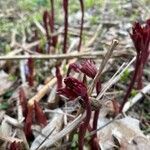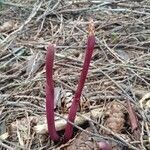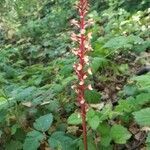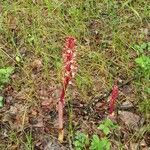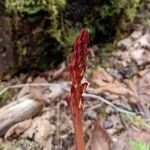Stems ± strongly thickened, base not bulbous. Inflorescences: racemes dense to lax, 10–65 × 1.5–6.5 cm. Flowers 6–41, conspicuous; perianth open; sepals directed forward to somewhat spreading, brown, tan, red, or yellow, often darker distally, lanceolate, 3-veined, 4.7–15 mm; petals frequently curved toward column, nearly adhering to it, tan to yellowish, often red distally, usually spotted with purple, lanceolate to oblanceolate, 4.5–11.5 mm; lip white, usually spotted with purple, obovate to elliptic, thin, lateral lobes 2, rounded, middle lobe oblong to broadly dilated toward apex, with 2 distinct basal lamellae, 4–9 × 1.5–6 mm; column whitish yellow, spotted with purple, usually curved, 3.3–7.8 mm, basally with ridges or poorly developed auricles; ovary 5–14 mm; mentum obscure, adnate to edge of ovary. Capsules pendulous, ellipsoid, 9–24 × 5–9 mm. 2n = 42.
More
Stem 2–6 dm, often pinkish-purple; infl 5–15 cm, fls 10–40; sep and lateral pet narrowly oblong to oblanceolate, 6–8 mm, 3(5)-nerved, the lateral sep somewhat divergent, the lateral pet ± spotted or suffused with purple; spur a prominent, sometimes divergent swelling near the ovary-tip; lip 6–8 mm, white, generally purple-spotted, with 2 rather small but evident lateral lobes below the middle and 2 short parallel ridges on the face, its terminal lobe rounded and deflexed, 3–4 mm wide. Woods; Nf. and Lab. to B.C., s. to Md. and Ind. and in the mts. to N.C., in the west to Mex. and C. Amer. July–Sept.
On leaf mold in woods. Moist to dry coniferous and deciduous woods, and conifer plantations, often in florests with little other herbaceous cover at elevations of 0-3700 metres.
